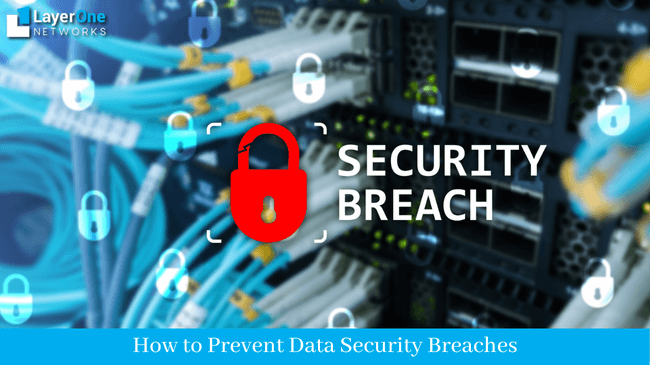Introduction:
For businesses in Corpus Christi, having a data security plan is essential to protect their data from malicious cyber attackers. Without a well-defined security strategy, organizations can become vulnerable to attacks that could devastate their operations and reputation. Partnering with reputed data security services providers like Layer One Networks is the fastest means to mitigate potential risks and stay safe from cyber threats.
In this guide, we will cover the following:
- What is a data breach, and what causes it?
- How are data breaches carried out?
- What are the potential risks and consequences of a data breach?
- What steps to take to prevent it?
What is a Data Breach, and What Causes it?

A data breach is a security incident in which an unauthorized individual has accessed sensitive, confidential, or protected data without the owner’s consent.
There are different ways that people can breach data, whether accidentally or intentionally. Common causes of data breaches include:
- Weak password protection
- Downloading malicious software or viruses,
- Phishing scams and other types of social engineering tactics
- Insider threats from current or former employees.
- Losing devices containing sensitive information
- Injecting malware or other malicious scripts into web pages
How are Data Breaches Carried Out?
Data breaches can happen to all sizes of organizations, and the methods by which attackers can breach data range from simple to complex.
However, according to Layer One Networks security experts, the breach occurs in 5 common steps.
- Step 1: Recon: Attackers gather as much information about the target organization as possible – such as IP address, open ports, and Software programs used.
- Step 2: Exploiting Vulnerabilities: Once attackers have identified any vulnerabilities in the system, they can exploit them to gain access.
- Step 3: Gaining Access: Attackers use malicious techniques such as phishing emails and malware to access the organization’s system.
- Step 4: Escalating Privileges: Once attackers have gained access, they will try to escalate their privileges by exploiting additional vulnerabilities to achieve higher system access levels.
- Step 5: Data Theft/Destruction: Attackers will then use their privileged access to steal or delete data or damage the organization’s systems.
What are the Potential Risks and Consequences of a Data Breach?

Data breaches can result in many severe consequences for organizations, including:
- Financial Losses:
In 2022 the average cost of a data breach in the United States was around $9.44 million more than the global average cost of $4.35 million. Although this figure includes breaches connected with huge companies, it can have serious financial ramifications for even the smallest businesses.
- Reputational Damage:
Data breaches may cause distrust in customers leading them to switch to another company. Continued data breaches can result in a significant negative impact on the reputation of an organization as well as its brand value.
- Productivity Losses:
Once a data breach has occurred, organizations need time to investigate, fix the issue and restore data. Spending this time can lead to significant productivity losses as employees cannot access the information they need or use the systems they rely on. On average, fixing a data breach can take around 3 to 4 months of a security team’s time.
- Legal Implications:
Organizations can also face legal implications due to a data breach, including fines and lawsuits.
- Ransom Demands:
Ransomware is a type of malicious software used by hackers to encrypt data and extort money from victims. The hackers refuse to decrypt the data until the ransom is paid.
- Privacy Compromised:
Depending upon the type of data that is breached, customers or clients may have their personal information compromised, leading to identity theft or other fraudulent activities.
What Steps can be Taken to Prevent Data Breach?

Data security is a must for any business in today’s digital world. However, organizations can do a few things to prevent data breaches.
Below are some effective cybersecurity prevention tips by data security services experts.
- Restrict Access:
You should restrict access to data and systems to those who need it by setting up password managers, two-factor authentication, and other access control measures. Limiting access can minimize the chances of a breach.
- Use Strong Password:
The most common cause of data breaches is weak passwords, enabling hackers to gain access easily. Furthermore, people often reuse the same passwords on multiple sites, making them even more vulnerable.
You should also set up password policies and enforce strong, unique passwords across all accounts.
- Keep Software up-to-date:
Always use the latest version of your software and keep all applications, operating systems, and plugins updated. These precautions will help patch any known vulnerabilities in the system which attackers can exploit. Furthermore, ensure the automatic updates are turned on and regularly check for any new patches that need to be applied.
- Use Secure URLs:
Users should only connect to websites that use secure HTTPS connections (instead of HTTP). HTTPS URLs are encrypted, making it much harder for attackers to access the data. Also, it is a good practice to only click on links from known sources.
- Regularly Monitor and Audit:
You cannot permanently deploy just one data security strategy to protect your business against all threats. For simple reasons, cybercriminals are highly motivated to steal data and constantly develop new tactics to breach the best security protocols and firewalls.
IT security services experts recommend regularly monitoring and auditing the networks to identify any security loopholes. This monitoring will enable you to quickly detect any malicious activities that have occurred to take preventive measures.
- Educate and Train your Employees:
Believe it or not, most data breaches today do not occur due to sophisticated hacks but usually because of human error. All it takes is one wrong click on a malicious link for an organization to fall victim to a data breach.
Layer One Networks, the best IT security services in Corpus Christi, TX, recommends the following steps to help protect your organization against cyber threats:
- Train your workforce to identify phishing emails, malicious links, and other social engineering attacks.
- Encourage employees to report any suspicious activities, no matter how minor they may seem.
- Enforce a strict policy against the use of public Wi-Fi for business purposes.
- Install anti-virus software on all corporate devices and instruct employees to only download apps from official app stores.
- Do not leave work with devices unattended or unlocked.
- Lock all filing cabinets and folders which contain sensitive information.
- Make sure all backups are regularly tested so you can be sure your data is secure in the event of an emergency.
- Never give out or share access to your devices, accounts, or networks with anyone.
Related Reads: Difference between Cloud and Network Security.
Join Hands with the Best IT Security Services to Prevent Data Security Breaches:
Data breaches can cause significant harm to both individuals and businesses. To protect against ever-evolving cyber threats, you must be vigilant and take preventive measures. Something most companies learn after experiencing one.
Layer One Networks provides comprehensive data security and managed IT services solutions in Corpus Christi, TX, to help protect your critical data and systems from malicious threats. We can help you develop and deploy a cyber security plan that meets your individual needs and train your employees to stay vigilant and identify potential threats.
To learn more about our IT security services, contact us today.

